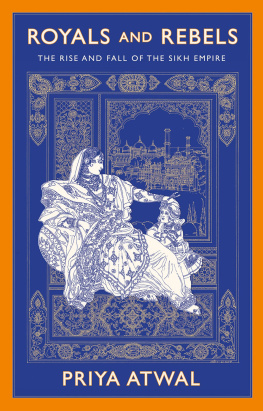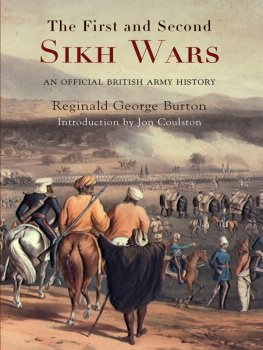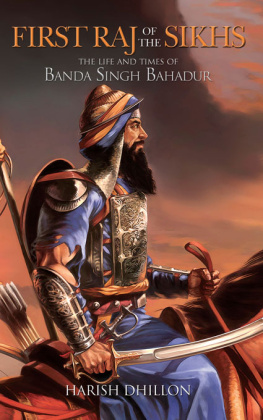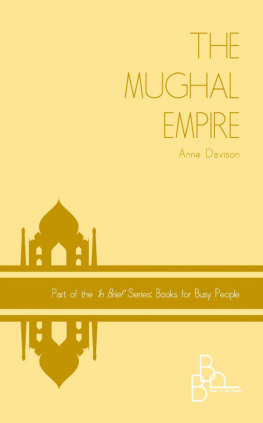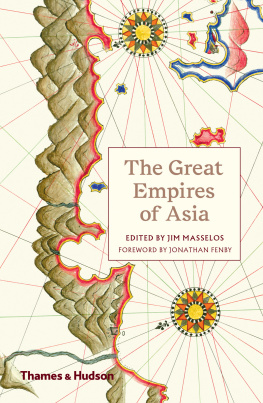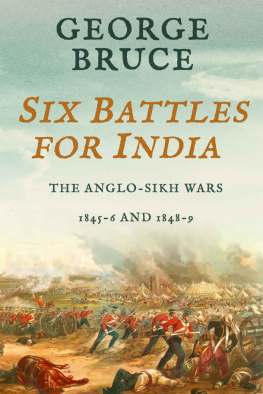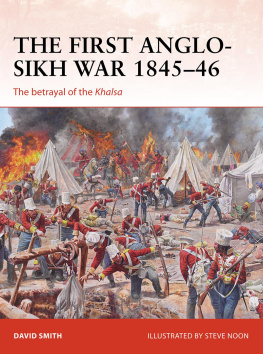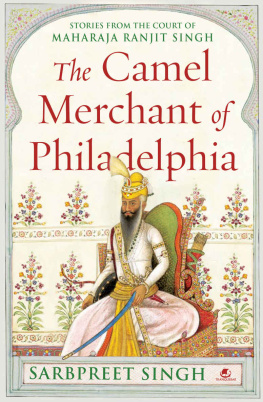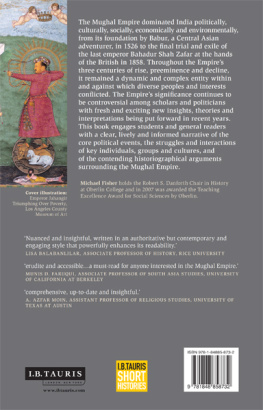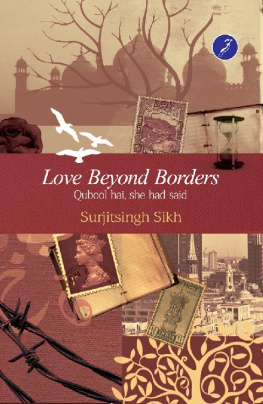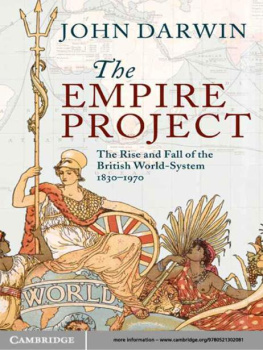ROYALS AND REBELS
PRIYA ATWAL
Royals and Rebels
The Rise and Fall of the Sikh Empire

HURST & COMPANY, LONDON
First published in the United Kingdom in 2020 by
C. Hurst & Co. (Publishers) Ltd.,
41 Great Russell Street, London, WC1B 3PL
Priya Atwal, 2020
All rights reserved.
Printed in the United Kingdom
The right of Priya Atwal to be identified as the author of this publication is asserted by her in accordance with the Copyright, Designs and Patents Act, 1988.
A Cataloguing-in-Publication data record for this book is available from the British Library.
ISBN: 9781787383081
ISBN: 9780197566947 (e-book)
This book is printed using paper from registered sustainable and managed sources.
www.hurstpublishers.com
Every effort has been made to trace the collection currently holding Figure 9, the portrait of Maharani Mai Nakain, which is available on Wikimedia Commons under a Creative Commons licence. The publisher would be pleased to hear from the collection-holder to rectify any error or omission.
CONTENTS
Map 1: The twelve Sikh misls or clans and surrounding powers, eighteenth century. Navtej Heer.

Map 2: The Sikh Empire and surrounding powers, first half of nineteenth century.
The author and the publisher thank the following for their kind permission to reproduce illustrations in this book: Aown Ali (AA), the British Library (BL), the British Museum (BM), the Kapany Collection (KC), the Samrai Collection (SC) and the Victoria and Albert Museum, London (V&A).
This book has been a long time in the making and the list of people I wholeheartedly wish to thank is equally lengthy, so these acknowledgements will probably only scratch the surface. The very first people I have to thank are my old friends from the Oxford University Sikh Society. A talk they organised eleven years ago about Patwant Singh and Jyoti Rais captivating Empire of the Sikhs was a remarkably fateful event in my life. Rupinder Ghatrora (the kind of friend who is also a bit like a big sister) told me strictly beforehand that, as I was the only History student in the group, I had better help out by asking the speaker a question, so that the Q&A wouldnt just be one big awkward silence. It wasnt a problem in the end: the talk captivated me to such an extent that Ive not been able to stop asking questions ever sincesorry if its got a bit much by now, guys!
I will never forget the strange and unexpected mixture of emotions that arose within me as I was listening to the speaker at that talk. Despite growing up in a Sikh family, and studying History at university, I had never otherwise learnt that a Sikh Empire had once existed; nor that such fascinating characters as Ranjit Singh or Jind Kaur had once been its living, breathing, royal rulers. I was excited and fascinated by this sudden discovery of an overlooked aspect of my heritage, but also angry and disappointed that I had been ignorant about it for so long. These feelings drove me to sign up immediately as a volunteer with the Anglo-Sikh Heritage Trail, which had contributed the speaker who gave such a great talk, so that I could start learning more as soon as possible. My passion for this subject, and particularly my insatiable curiosity about the intriguing political career of Maharani Jind Kaur, kept me going long enough thereafter: first to write an undergraduate thesis, and then to undertake a PhD, so that I could research this history in as much depth and breadth as possible. It feels so exciting now to be sharing these findings with new readers in the form of a book, which I sincerely hope will ignite the spark of curiosity amongst more of us. There is so much more to learn about this fascinating period of history, and there are still so many important questions to be asked.
There are many people whose support and generosity have helped me to develop the ideas and research underpinning this book (all blame for any faults or mistakes of course lies with me). I wouldnt have been able to imagine and learn about Punjabi society in anywhere near as much depth had it not been for the support of Stephen Gucciardi and Mozghan Samadi in teaching me to read Punjabi and Persian; and also of Sahba Shayani and Zahra Shah, who translated and helped me to interpret passages of tricky Persian handwriting. I am also grateful for the help of staff at the Bodleian Library, the Royal Asiatic Society Library, the Royal Archives and the National Records of Scotland. I would like to offer particular thanks to the staff who work in the Asian & African Studies Room at the British Library, whose wit and good humour made my many visits there over the past eleven years extremely enjoyable.
My ideas on the Sikh Empire began to take formal shape under the wonderful guidance of Rosalind OHanlon, first as my undergraduate thesis supervisor and then as an examiner for my doctoral thesis. My work has been deeply enriched by her insightful comments and by learning from her invaluable expertise on early modern Indian history. I have equally to thank Peter Singh Bance for being so generous in sharing his incredible collection of Duleep Singh family artefacts and his own personal knowledge with me over the past ten years, since I first turned up at his office with a ton of questions about Sikh Empire history! I am also grateful to the incredibly generous colleagues and advisers who have read various thesis drafts for me over the years: Pritam Singh, Radha Kapuria, Amar Sohal, Nadhra Khan, Margret Frenz, James Belich and Miles Taylor. Each of you pushed me to think more deeply and creatively about my writing, and my work has benefitted immeasurably as a result. However, my biggest thank you in this regard has to go to my DPhil supervisor, Faisal Devji. Faisal has the most awe-inspiring intellect, combined with a quietly kind, generous natureit was my immense good fortune to have the opportunity of working with him. It was also Faisal who encouraged me to be ambitious with the scope of this book, and not to shy away from tackling the entire rise and fall of the Sikh Empire, so I particularly hope he enjoys the result!
On that note, I also have to thank Michael Dwyer, for taking a chance on me as a first-time author. The time and encouragement that he personally gave me in the early stages of writing were incredibly kind, and I am delighted to have found such a happy home for my book, with Hurst. Thanks to Rhianna Louise for her publicity support, and to the two anonymous reviewers who kindly provided valuable, constructive feedback for the development of my manuscript. The biggest star is my editor, Lara Weisweiller-Wu. I feel like the luckiest writer in the world to have had Lara in my corner. She is incredibly smart, thoughtful and patient, and has been such a champion in helping me to say and achieve what I wanted to with the writing of this book. I have been deeply touched by the energy and care that she has dedicated to this volume, and cannot thank her enough.
Alongside the manuscript itself, I am delighted to be able to share a beautiful array of images in the pages of this book. I am honoured that the Samrai Collection has kindly agreed to let me print a number of previously unpublished paintings in its rare and wonderful collection of original artwork from Maharajah Ranjit Singhs court. Alongside these, I am equally grateful to Aown Ali for permitting me to print his photographs of the crumbling, but still fascinating, remains of Sikh royal architecture in Pakistan. Such visual sources have been immensely important in deepening my understanding of the lived dynamics of this period; helping me to uncover rich and sometimes forgotten perspectives that written sources perhaps only hint at. They are also treasures for the eye, and I hope that readers of this book enjoy studying them more closely. Another stunning image adorns the jacket of this volume: the fantastic cover illustration is by the extraordinarily talented Singh Twins. I am a huge fan of their work, and feel a thrill of excitement and gratitude every time I look at the cover.

